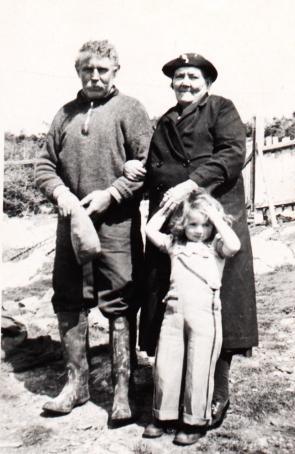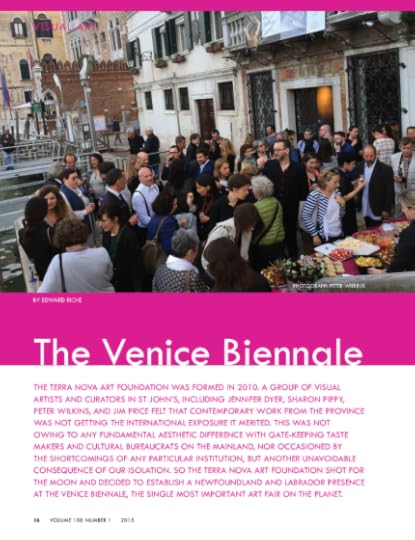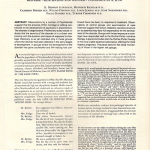Edward Riche's Blog
May 8, 2016
My Mother
Mark Chippett (1881-1953) and Melina Rowsell (1879-1957) at Leading Tickles, Notre Dame Bay, Newfoundland. The girl is their great niece, Cynthia Bridger, my late mother.
February 7, 2016
Today I Learned It Was You

When a retired actor who frequents a city park is purported to be transitioning from man to deer, municipal authorities in St. John’s, Newfoundland, find themselves confronted by an exasperatingly difficult problem.
Complications mount as advocates, bureaucrats, police, and local politicians try to corral the situation, which escalates into an even bigger problem after the story blows up on Facebook. Leading the charge is the mayor himself. A former professional hockey player and local hero, Mayor Matt Olford is juggling a number of personal challenges on top of his city’s man-deer problem: his wife has become a born-again Christian and he’s found himself attracted to one of his colleagues at City Hall. When the Prime Minister’s office calls to ask if he’ll run as a Conservative in the next federal election, Mayor Olford finds himself at a crossroads: Surrender his political values or remain as the sole voice of reason on the increasingly ineffective city council?
Hilariously sending up the drama and dysfunction of local politics, overzealous rights activists, and perils of contemporary social media, Today I Learned It Was You is another bitingly brilliant comic novel from one of Canada’s funniest and most astute literary talents.
Forthcoming April 16, 2016
December 19, 2015
Last Breeding Pairs
I thought this piece I wrote for the April 2014 edition of The Overcast should be revisited in light of St. John’s Council slashing its grants to artists by 50%
Last Breeding Pairs
“Absolute bullshit”, declared Danny Williams of the Conference Board of Canada’s population projection for Newfoundland and Labrador. Rather than a ballsy stand against math I suspect our prickly former Premier misread doubts about our spirit of enterprise into an extrapolation of deaths verses births and current rates of immigration.
Demographics, it is said, are destiny. If we don’t commence breeding like rabbits, and/or our diaspora return, the Newfoundland and Labrador we know will cease to exist. Without a bonanza of bay-bies there will be no one to pay taxes and so no means of diapering the few remaining specimens of Homoterranovas.
Williams and others argue that untapped oil under our sea promises industrial activity that will lure people to our shores. That’s by no means certain. Banking on commodities is a mug’s game and the North Sea precedent doesn’t suggest that expanded hydrocarbon extraction would create the jobs required to avert the crash we face. The disinterested architecture of that tower violating the parking garage at 351 Water Street betrays how short-lived are non-renewable plays. A legacy building it ain’t. Oil will, for a time, be our economy but what we really need is diversification.
Why would anyone move here? There are Hooters and Boston Pizza in places with higher wages. No one comes for the climate or the easy access it affords … anywhere, save Fogo. There are only four reasons someone will relocate to Newfoundland and Labrador; for love, to plunder resources, for the natural world, or because of the vitality of its culture. It’s this last attribute that will allow us to attract the artists that are the primary agents of economic diversification.
“Follow the paint” is a New York real estate adage recognizing the role artists play in revitalizing neighbourhoods. Richard Florida famously identified the “creative class” as a key engine of growth. You can hate them, but the economy needs painters and writers and players because they are the wellspring of the crazy new ideas that spawn innovation and invention.
From where will they come? Housing is extortionate in Vancouver, Toronto is ruled by hillbillies and Halifax has the misfortune of being in Halifax. Easy pickings. Perhaps we can even entice some of the homegrown talent we’ve exported to countervail our trade imbalance in hockey players.
Coupled with funding to a national standard we can trigger the migration by eliminating the provincial income tax for bona vide, full-time, professional artists resident in Newfoundland and Labrador. The province loses little to gain much. It’s not an original idea, in Ireland
“Section 195 Taxes Consolidation Act 1997 empowers the Revenue Commissioners to make a determination that certain artistic works are original and creative works generally recognised as having cultural or artistic merit.
The first €40,000 per annum of profits or gains earned by writers, composers, visual artists and sculptors from the sale of their work is exempt from income tax in Ireland in certain circumstances.”
Danny Williams is all over his Irish roots, I wager it’s an idea he’ll get behind.
November 11, 2015
Paris
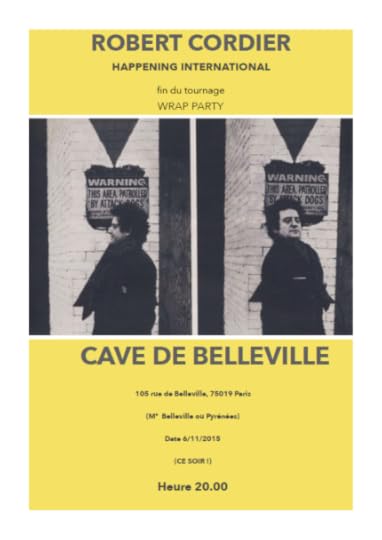 Not long back from a couple of weeks directing a film in Paris. The project is the brain child of my old and dear friend and colleague Steve Palmer. Steve and I wrote and performed on The Great Eastern and related undertakings. Steve’s now a Professor at the University of Windsor with a special interest in the History of Medicine.
Not long back from a couple of weeks directing a film in Paris. The project is the brain child of my old and dear friend and colleague Steve Palmer. Steve and I wrote and performed on The Great Eastern and related undertakings. Steve’s now a Professor at the University of Windsor with a special interest in the History of Medicine.
During research into the Man and His Health pavilion at Expo ’67 Steve discovered a lost and, at the time, lauded film used as part of that exhibition. It was directed by the Belgian/French/American film and theater director/poet/actor Robert Cordier. Steve learned that Cordier at 82 years of age was alive and working in Paris.
Cordier is 20th century art personified. He knew Jean Genet and Orson Welles. He was a friend and collaborator with the likes of Alan Ginsberg, Andy Warhol, Ava Gardner, James Baldwin and Salvador Dali. The associations are too many to list.
Cordier wasn’t interested in another conventional documentary about his life and Palmer was only too happy to oblige; planning something about Cordier and larger themes relating to art, wellness and, in the context of Expo ’67, the subsequent efforts by the forces of neoliberalism to destroy what was built by Pearsonian liberalism all wrapped up in a meta-narrative about the making of the Cordier movie itself.
Too ambitious? Utterly mad? Both, surely.
I’ve witnessed Steve pull off such narrative acrobatics before so he can do it.
And the shoot went better than anyone could have dreamed. The operating director of photography Enrico Giordano proved to be an ace, the interview subjects were witty and wise, the ground team led by the writer Christopher Mooney were heroic and Paris did its best-city-in-the-world act, turning sunny during a normally grey season, acting sexy, being smart. Even the one gendarme the production collided with was gracious and accommodating. Cordier was brilliant. Steve returns to North America with many hours of wonderful footage.
The edit will be daunting but my friend is off to a terrific start.
August 15, 2015
July 2, 2015
The Venice Biennale

Photo: Peter Wilkins
It was bold move but one exploiting the natural connection between Newfoundland and the home of its oft purported discoverer, the Venetian citizen (though born in Gaeta near Napoli) Zuan Cabboto. And there is something sympathetic about the Comune di Venezia and St John’s; the fetid hum of tidal waters, a cuisine with salt fish at its centre, the louche ways of old ports. The brazenness of the proponents has paid off with two successful shows at the Venice Biennale; 2013’s About Turn, new bodies of work by Will Gill and Peter Wilkins, co-curated by Mireille Eagan and Bruce Johnson (both then of The Rooms), and this year’s Under The Surface, featuring the work of Jordan Bennett and Anne Troake, and curated by Chris Clarke, Senior Curator at Lewis Glucksman Gallery, University of Cork, Ireland.
A French artist might put the 2015 Venice Biennale’s theme “All The World’s Futures” as a question, one purred with detachment, posed with a pout, “Tous les Futures du monde?” It would be voiced but also appear as text on a screen. In form, at least, the future doesn’t look so different than video art of the 1990s.
The answer to that existential question about the world’s fate could be “crowds and catastrophe capitalism.” The cost of neoliberal economics, the growing chasm between the .01% and the rest preoccupies this, Venice’s 56th Esposizione Internazionale d’Arte. The many parts of Africa are justifiably aggrieved, making art from spent shell casings and rags. Greece is pissed-off and bleak. There are protests by the Gulf Labor Artists Collective over conditions at the Guggenheim Abu Dhabi construction site. One piece involves the reading aloud of the entirety of Das Kapital for Pete’s sake.
Coming from Canada, where decades of cuts have culled their ranks, it’s hard to fathom that there can still be so many artists, critics, and culturecrats in the world. On preview week, May 4-8, they packed into the Giardini, the dedicated park in Castello, the eastern most of Venice’s six sestieri (neighbourhoods), by the thousands, stopping occasionally for a revitalizing prosecco, scurrying between the various national pavilions like ants raiding a picnic.
They come to a critical consensus about work featured in the Giardini, or the big curated show at the nearby Arsenale, so quickly that one wonders if those writing about it arrive with their conclusions in their carry-on.
Critics are grousing that this socio-economic fixation is lending the event a grim, study hall tone but there is enough political and economic naivety and downright foolishness to leaven the proceedings. Besides, some of the most vulgar yachts to sail the seven seas are tied up mere paces from the entrance gates and many of the pieces on display rely on costly elements of scale (the massive mirror in J David’s Apotheois at the Czech and Slovak pavilion, the giant gas mask by Irina Nakhova at the Russian) for effect. Despite complaints there are no revolutionary stirrings troubling the waters of the lagoon.
The Arsenale is just that; a commodious, nearly continuous network of warehouses used from 1104 until 1797 as stores and armories by the Venetian Republic’s then mighty navy. The exhibitions run, even brain-bleed, together at the Arsenale. Here the art is put in custodial as well as curatorial context. The volume of one piece’s audio (there are many noisy pieces) can muddle another’s. It’s an even more overwhelming experience than that of moving from building to building in the Giardini, a Stendhal syndrome-inducing onslaught of art.
Beyond these two main venues there are “collateral” events all over Venice. Newfoundland and Labrador’s exhibition is almost dead centre of the city, at the Galleria Ca’ Rezzonico, right on the Grand Canal and so in one of the more enviable locations.
The national pavilions in the Giardini are handsomely resourced, big budgets showing in plentiful staff, well-kept gallery space, and fat glossy catalogues. Equally lavish spending could be seen at most of the collateral events. Not so the Newfoundland and Labrador show which is as much expedition as exhibition. Without money for a lead team Troake, Bennett, Wilkins, Clarke, and Amy Malbeuf (Bennett’s partner and artistic collaborator) had to race to prepare the gallery space and install the show themselves immediately upon arrival. Just days before opening both featured artists and curator were painting walls and sewing and hanging curtains, wiring projection and audio systems. They were mopping the floors. On the last three nights leading up to the opening, work continued until four in the morning. Being selected to represent Newfoundland and Labrador guarantees an otherwise unimaginable level of exposure but without considerable state or corporate support it is anything but glamourous.
But the labours were rewarded. The crush at the opening of Under The Surface seemed of an altogether different nature than that at the Giardini or the Arsenale, with those spilling from the gallery space onto the Calle Traghetto Vecchi, befitting the immediate response to the work, giddy, but also strangely at peace. It was a blissful moment even for a place known as La Serenissima, The Most Serene Republic.
Ice Fishing, Bennett’s installation, included audio and video of the artist ice fishing with his father, striking documentary photographs, and most prominently, an actual ice-fishing shed, a saucy slap at the sort of diorama one might see at a natural history museum, a sly auto-ethnography. Visitors were invited to engage with the piece by sitting, as if fishing through holes in the floor of the gallery, on upturned 10 gallon salt beef buckets. The water below the holes was evoked with video, giving a sense, in the watery Venetian setting, of the gallery being afloat. Troake’s 3D video of human movement amongst the primordial webs of roots in a tree fall, OutSideIn, was as mesmeric as anything on show in Venice this year. Troake had set out to make a dance film; “Carol (Prieur), Bill (Coleman), and I were most interested in attending to minutiae–of human movement and of the place. I set up situations and we just explored with the camera rolling.” The video’s evolution into something more than a record was organic and, to judge from the piece’s success, somehow inevitable. The 40-minute video had accidental echoes of the French installation, Céleste Boursier-Mourgenot’s kinetic, if logy, tree and root ball, with Troake bringing a vitality wanting in the French program. (Uprooted and fallen trees were common themes this year.) The video runs in six chapters, the first five detailed explorations of the human form moving through the uprooted world, the last a lusher painting in pixels, as fluid as wet paint.
In his curatorial statement, Clarke says Under The Surface “captures the centrality of landscape to the province’s culture and its inhabitants.” The gallery setting in Venice, as “Old World” as you want, proved a tremendously effective contrast for this work, messages from the terra incognita to a centre of the civilization, from the wild to the place they tamed the tides. Both Bennett’s and Troake’s pieces seem to have tunnelled their way here to emerge from beneath Venice, Troake from the earth, Bennett from the surf. So much other work on display this year has a feeling of having been delivered by cargo plane. In a year that was so political, the Terra Nova Art Foundation show stood apart for being so primal.
Collateral events, like the Newfoundland and Labrador presence on the Grand Canal are there, unlike the more widely publicized shows in the Giardini and the Arsenale, to be discovered. The situation of the Galleria Ca’ Rezzonico, mere steps from a busy Vaparetto (Venice’s public transit system of boats) stop means Under The Surface will be visited by as many as 30,000 people before it closes, owing to the annual flooding, the Acqua Alta, in early November. The lofty goals of The Terra Nova Art Foundation will have been met and surpassed. There is such tremendous exposure for the Province at the event; more than five million people will see the banner outside the gallery. It seems certain that the Government will find a means to increase support for the effort.
Every Biennale is met with big questions about its relevance. It can’t help but be uneven and of the elites. Sea changes to the forms don’t occur on any clock, certainly not biannually, so there is always some frustration at the sense of having seen things before. An event so large and considered cannot be asked deliver the shock of the new at every turn.
But with the 9th century nihilists of ISIS destroying icons and images in Assyria we can only but herald those who labour to replace them. The persistent will to make art in the face of horror represents the world’s best future, as artists like Anne Troake and Jordon Bennett represent ours.
Edward Riche writes for screen, stage and print. His latest novel, Today I Learned It Was You, will be published by House of Anansi Press in 2016.
Reproduced courtesy The Newfoundland Quarterly, Vol. 108, No. 1, 2015
The Venice Biennale [PDF]
January 29, 2015
A Year Old Column
When local real estate mogul Charlie Oliver announced that, instead of running for the Tory leadership, he was going to sponsor a think tank to tackle the intractable problems facing Newfoundland and Labrador some joked a barrel was a more apt vessel in which to ferment local ideas. Certainly, to meet Heritage guidelines, the container should be made of wood. Rather than a National Think Tank we need a Notional Puncheon.
It’s a capital idea. Boom or no we remain a tiny and isolated population. It’s difficult to float challenging ideas in so small and close-knit a community. Say things people don’t want to hear and you will come face to face with someone you’ve offended within the week. You don’t anymore hear the expression; “Wouldn’t say “shit “if his mouth was full of it” because it’s sort of a self-fulfilling prophecy. Having a Notional Puncheon increases the odds of getting bad news before it’s too late.
So I provide a short list of things that you cannot say in town as inaugural talking points for the institute or tank or tub or whatever it ends up being called.
-the future price of commodities (including energy) cannot be predicted with accuracy
-despite ceaseless crowing to the contrary Newfoundlanders don’t actually much care for and so do not in any meaningful way support their own arts and culture
-a solution to both the unfunded pension liability and the skyrocketing cost of health care is to have people die sooner by denying them life-extending care at some threshold age.
-a significant cause of soaring health care costs is profiteering
-it’s not viable to provide ferry service to everyone who wants it
-as we come to define the nation as a place to conduct business (as opposed to a place of which we are citizens) corporate taxation has to contribute much more than 8% to the revenue side.
-asphalt does not work as a road surfacing material in our climate
-Big Oil owns and/or influences many politicians and most news media in Canada
-MBAs make a company more profitable, less fun and shorter lived.
-there’s a surfeit of hockey.
-few defenders of CBC television can actually bear to watch it
-how is it Newfoundlanders are so self-congratulatory and yet in constant need of approbation from the crowd on the mainland?
– forget Blackouts ’94 and 2014 the real worry is Starve-Out 20XX as we only have seven days food supply on the island.
– St. John’s City Council doesn’t grasp some central concepts of urban development because some members are too stunned.
The vessel is going to have to be enormous to accommodate the deep thinking required to address our problems. I doubt we any longer have the coopers capable of fashioning such a thing from staves. Maybe it should be made of reinforced fiberglass or some newfangled composite. The way things have been going we’ll end up buying a used think tank from a Scandinavian country and shipping it over here to find it only takes Danish ideas.
January 21, 2015
From the archives
El Dorado Journal of Medicine – April 1, 1987
SPECIAL ARTICLE
THE DEVELOPMENT OF PSYCHOSIS AFTER CHRONIC MOTION PICTURE
MONTAGE – FILM EDITING AND MADNESS – CINEDEMENTIA A, B, C6
E. DERMOT LLOYD M.D., HEINRICH RlCHLER M.D.,
CAMERON PORTER M.D., WALDO PIDGEON M.D., LOUIS JEMEAL M.D., IGOR NORMINSKI M.D.,
PAULO DAMIRO M .D., TURNER THOMPSO M.D.
ABSTRACT. Observations by a number of Psychiatrists suggest that the process of film montage or editing contributes to the development of psychosis in practitioners. The disorder is degenerative. Preliminary study results indicate that the severity of the with the duration and nature of exposure to montage. Recovery is as yet recorded only in those groups where the disorder has been detected in the early stages of development. In groups where the development of the disorder has gone unchecked and film editing has continued there has been no response to treatment. Observations of control groups and examinations of case histories suggest that factors related to narrative structure (or its absence) may bear full responsibility for the development of the disorder. Groups with limited exposure to montage have responded well to the Richler-Porter narrative therapy. A panel concludes that the Richler-Porter therapy is the most viable treatment alternative, offering the most hopeful prognosis. The panel calls for the close monitoring of those in the higher risk groups.
An unusually high rate of psychosis has always been noted fl.in the population of Newfoundland, Canada. It has been generally accepted that the prevalence of psychotic disorders on the fog bound island was the result of readily identifiable environmental factors (poor diet, limited exposure to sunlight, isolation, chronic alcoholism) and hereditary factors (see El Dorado Journal of Medicine, June 12, 1979: FAMILY SWIM AT THE GENE POOL).
This view first came into question in 1982 when Dr. Heinrich Richler noted that societies with a strong oral tradition had an uncommonly high rate of psychotic disorder. Richler travelled to Newfoundland and undertook an exhaustive study of the population in an attempt to establish causality. Richler relied heavily on accounts of psychotic behaviour by the indigenous population. These accounts were recorded and published under the title LOTS OF FOOLISH ONES ‘ROUND HERE. An excerpt follows:
Dr. Richler: You suggested that Heber’s behavior was unusual.
Mrs. Fudge: They was all foolish.
Dr. Richler: The entire Noseworthy family?
Mrs. Fudge: Yes, the lot of ‘em. I suspects they got it from their father. We called he Foolish Ned. Their mother now, he was right sensible like, never carrying on. But Ned was always tellin’ the biggest kind of lies, ‘specially to youngsters or any stunned enough to believe he.
Dr. Richter: He was a compulsive liar?
Mrs. Fudge: Not lies like you’re sayin’ now, but stories, and they only for badness.
Only for badness or because of madness? Dr. Richler felt that the compulsive construction and relation of fictional narratives might in some way be linked to Dementia. Richler related these thoughts to Dr. Cameron Porter in St. John’s who, at the time, had several patients in his care who shared an experience in the film medium. Dr. Porter suggested that Richler observe filmmakers in the editing process, where narrative structure was frequently manipulated, in the hope of identifying the development of symptoms. Richter’s subsequent observations were the first step on the road to a clear understanding of the disorder. He noted,
Subject D.N. would quickly become agitated if he perceived even a minor flaw in the continuity of time and/or space in a motion picture sequence. The unedited film offered no promise of resolution for the material he required was not in evidence. Futilely he would attempt to correct the perceived flaw by; manipulating the order of the dialogue, inserting non-relevant photographic material (he called these “cut-aways”), planning to insert new dialogue where there was no record of that dialogue, and so on. The process disturbed his perception of chronology and he freely exchanged the terms “before ‘and “after”. As his frustration increased there was a clear change in his behaviour. He began issuing obscenities and made violent references to the material such as “I’ll cut the head right off that!” and “I’ll kill that in the mix”. Convinced that he could find no resolution he abruptly suggested that we should become intoxicated whereupon the solution to the narrative problem would come to us as in a dream or visionary experience.
Richler saw immediate evidence that prolonged episodes of motion picture montage resulted in more discontinuous narratives in the films themselves. It appeared that the duration and nature of exposure to montage had a direct link to the seriousness of the disorder.
In one extreme case the subject had been editing the same film for almost ten years. His mental condition was widely reported to have deteriorated considerably over this period. The film narrative which finally emerged from this process was disjointed and absurd. The narrative had no proper chronology, with events from the past present and probable future being fused into a singular time frame that clear1y existed only in the filmmaker’s greatly troubled mind. When I brought this to his attention he rambled incoherently about “levels of reality” and his own search for meaning. He said, “I have to prove that I exist”. The filmmaker saw his ten year effort as a personal odyssey with himself as mythical hero. In as sad a case as I have ever studied the filmmaker had plainly mistaken chaos for order, order for chaos. He had abandoned reality and truly gone completely insane.
Control Group Results
After reviewing a number of such cases and working closely with Dr. Porter and his wards, Richler more firmly established the cause of the disorder (by this time termed Cinedementia or Kinodementia) through closely monitored exposure in control groups.
Group A were asked to edit a short sequence in which an enraged man kills his wife’s pet ermine. They were given two working days to assemble the sequence. Richler recorded subtle changes in behaviour and moderate anxiety in this group. Three days after the experience the group’s behaviour returned to normal.
Group B were asked to edit a longer sequence in which an enraged man, recalling his expulsion from Rumania kills his wife’s pet ermine and is later tormented by visions of the dead creature.1 They were given five working days to assemble this sequence. Richler recorded considerable changes in behaviour and extreme anxiety in this group. Violence was reported from one subject. The marked change in behaviour was attributed to the increased complexity of the narrative. The anxiety was the product of the difficult decision making process. Subjects had to decide whether to present the information in chronological order, with Rumania first, then the murder of the ermine and finally the vision; or to “flash-back” to the Romanian past as the man killed the ermine (again followed by the vision); or to begin with the vision and then seek out its roots by returning to the ermine’s death and Rumania. One subject became so distressed that she had to be removed from the experiment after two days. Her roughly edited sequence suggested that the enraged man murdered the ermine and was expelled from Rumania for having done so by the victims gigantic parent (as presented in the dream sequence).
Group C were asked to edit a still longer sequence in which an enraged man, recalling his expulsion from Romania, kills his wife with her own pet ermine during the stage performance of the scenario edited by Group B. A medical ethics committee halted this experiment fearing irreparable consequences for the subjects.
Therapeutic Regimes
Convinced the cause of Cinedementia had been identified Richler, in concert with Dr. Porter, set about developing a therapeutic regime for those suffering from the disorder. The treatment demands that the patients first limit daily activity to a bare minimum and at regular intervals relate their activities to a second party. Should they report events or emotions out of chronological order or with embellishment they are subjected to painful electric shocks from.electrodes attached to their fingers and eyelids. Gradually the environment of the patient is enriched and the demands for objective recall increased. In the final stages of the treatment patients arc deliberately exposed to unlikely occurrences such as bleeding electrical outlets, exploding food, talking furniture and so on. If the patient relates these events without trying to establish a rationale or causality the treatment is judged to have been successful and the patient is released from care. If three months after the termination of treatment the patients imagination appears hopelessly stifled one can say, in all fairness, that he or she has been cured.
1. The vision was photographically realized by employing miniature sets which created the illusion of a gigantic, threatening ermine. The original, unedited motion pictures for the experiment were produced and directed by Dr. Cameron Porter .
September 7, 2014
Tree hugger
September 2, 2014
A Wild Pitch
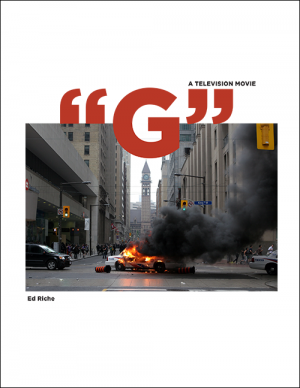
One is forever “pitching” film and television projects. Only a portion get developed into scripts and fewer still get made. This orphaned project is interesting for a couple of reasons. Firstly, it was received in all quarters with the enthusiasm usually reserved for anthrax. The producers shopping it (I’ve excised their names from the document) were told that it couldn’t be made given Canada’s current political climate. I believe that was unwarranted paranoia. I seriously doubt the man is paying that much attention. My motivation was aesthetic and practical not political; it seemed to me the events surrounding the G20 Summit in Toronto were a rare case of some genuine intrigue and action in a Canadian setting so obvious source material.
And curiously, the main character in this Toronto, 2010 set tale makes an appearance in my forthcoming St. John’s, 2013 set novel, “Today I Learned It Was You”. So it wasn’t a complete waste of time.
Edward Riche's Blog
- Edward Riche's profile
- 19 followers


